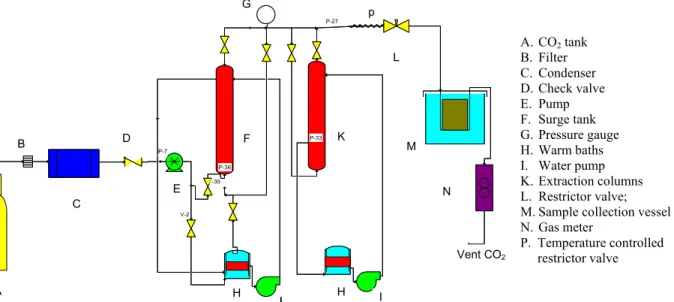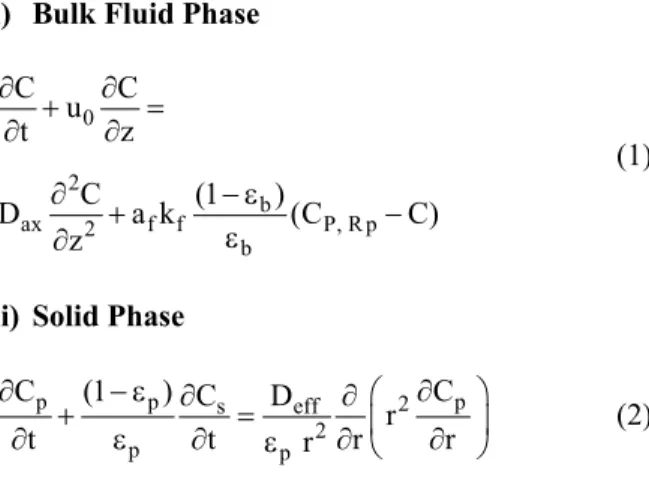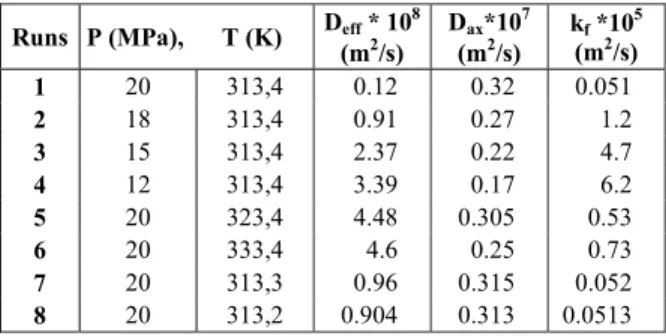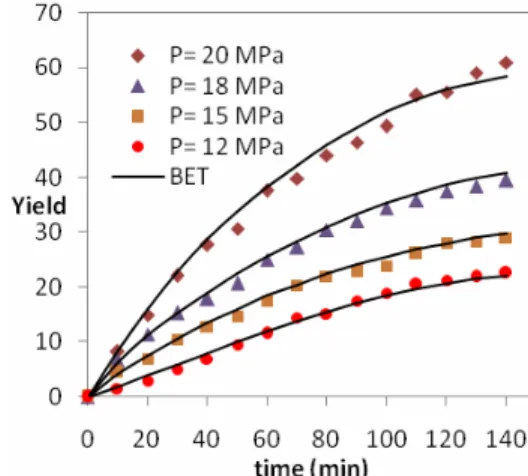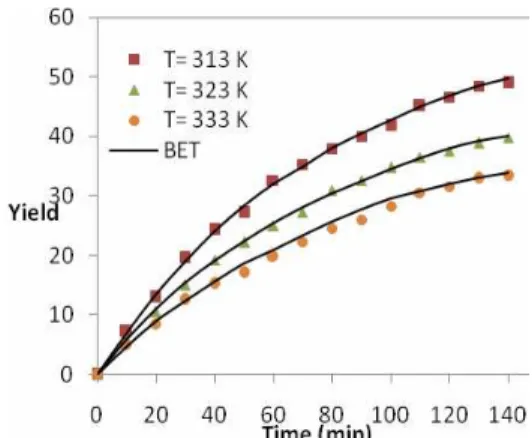ISSN 0104-6632 Printed in Brazil
www.abeq.org.br/bjche
Vol. 30, No. 01, pp. 159 - 166, January - March, 2013
Brazilian Journal
of Chemical
Engineering
MATHEMATICAL MODELING OF
SUPERCRITICAL FLUID EXTRACTION OF OIL
FROM CANOLA AND SESAME SEEDS
B. Honarvar
1*, S. A. Sajadian
2, M. Khorram
2and A. Samimi
21Chemical Engineering Department, Science & Research Branch, Phone: + 989173145175,
Fax: + 987116247155, Islamic Azad University, Fars, Shiraz, Iran. E-mail: honarvar2@gmail.com
2Chemical Engineering Department, University of Sistan and Baluchestan, Zahedan, Iran.
(Submitted: November 14, 2011 ; Revised: April 20, 2012 ; Accepted: April 20, 2012)
Abstract - Mathematical modeling of supercritical fluid extraction of oil from canola and sesame seeds with a two-phase model was performed in this work. A model based on differential mass balance was used to correlate the experimental data. Different adsorption isotherm models (Henry, Freundlich and Brunauer, Emmet and Teller (BET)) were used to describe the equilibrium state. Three model parameters such as effective diffusivity (Deff), mass transfer coefficient (Kf) and axial dispersion coefficient (Dax) of the bed were
used as fitting parameters. The experimental data for yields were obtained at pressures of 10-20 MPa, temperatures of 313-333 K and solvent flow rates of 2-4 g/min. From the results, a nonlinear adsorption isotherm exhibited better agreement with experimental data of yield than a linear model in the range of studied conditions.
Keywords: Mathematical modeling; Interaction solute-solid; Isotherm; BET; Freundlich.
INTRODUCTION
Mathematical models are powerful and useful tools for design and scale up of SCFE processes and, since the laboratory scale up to pilot and industrial scales and the cost evaluation of processes cannot be done without mathematical modeling, several attempts at mathematical modeling of supercritical fluid extraction processes have been proposed. Three different approaches have been proposed for SFE mathematical modeling. The first approach is based on the use of an empirical kinetic equation to describe experimental data (Naik et al., 1989; Ngueyn et al., 1991; Subra et al., 1998; Silva et al., 2008). These empirical relations are useful when there is no information about equilibrium relations and mass transfer mechanisms. Their advantage is their simplicity, but these models are not adequate for scaling up. Other authors have proposed models based
core model to describe extraction of ginger root with supercritical fluid. This model assumes that the solute is condensed within pores in solid particles and a sharp boundary develops between an oil-rich core in the porous particle and an extracted outer region where the core shrinks as the extraction proceeds. Goodarznia and Ekani (1998) proposed an unsteady state mass balance for solute in a single particle coupled with a fluid phase balance on a differential section of the bed. Internal diffusivity, mass transfer coefficient to the bulk phase and the effect of axial dispersion in the fixed bed are parameters of the model. The extraction of triglycerides from used frying oil with liquid and supercritical ethane has been studied in a semi-batch system at different operating conditions by Rincon et al. (2011) and kinetics and selectivity of supercritical carbon dioxide (SC CO2) extraction of Helichrysum italicum flowers were analyzed at different operating conditions by Ivanovic et al. (2001). Rosmarinus officinalis (rosemary) extracts were obtained in a supercritical pilot-scale plant based on experimental information available in the literature for analytical or low-scale processes under different operating conditions by Garcia-Risco (2011).
The scope of this study was the supercritical fluid extraction oil of canola and sesame seeds oil performed under some different operating conditions. The experimental results were used to develop a model of the extraction process. Many researchers have considered the Henry isotherm because the Henry relation is simple and linear (Goto et al.,
1996; Reverchon, 1997; Gooderznia and Ekani, 1998; Reverchon, 2001; Carvalho et al., 2012). Goto et al. (1998) proposed a Brunauer, Emmet and Teller (BET)-type equilibrium relationship for SFE processes where the solute interacts with the solid matrix. Fatemi et al. (2008) applied different isotherms (Henry, Langmuir, Freundlich and Toth) to describe the interaction between solute-solid in the extraction of valerenic acid from Valeriana officinalis L. Ghoreishi et al. (2001) employed the Freundlich isotherm for the modeling of supercritical extraction of mannitol from pane tree leaf. In this work, linear (Henry) and nonlinear adsorption (BET, Freundlich) were used to describe the interaction between oil and seed. This model takes into account mass transfer, solute-fluid interaction (solubility) and solute-solid interaction (adsorption). At equilibrium, the distribu-tion of solute between the solid phase and the supercritical phase is determined by the adsorption isotherm. The adsorption isotherm of oil in the supercritical fluid was modeled by using the different isotherms, such as a single parameter equi-librium relation (Henry), two-parameter relations (BET, Langmuir and Freundlich) and three-parameter relations (Langmuir-Freundlich and Toth).
MATERIALS AND METHODS
Figure 1 shows the schematic diagram of the extractor apparatus. The extraction experiments were carried out in a bench scale SC-CO2 apparatus.
G
B
C D
E
F K
M
N
H H
I I
L p
Vent CO2
A
P-36
P-33 P-27
P-7
-35
V-2
G
B
C D
E
F K
M
N
H H
I I
L p
Vent CO2
A
P-36
P-33 P-27
P-7
-35
V-2
B
C D
E
F K
M
N
H H
I I
L p
Vent CO2
A
P-36
P-33 P-27
P-7
-35
V-2
A. CO2 tank
B. Filter C. Condenser D. Check valve E. Pump F. Surge tank G. Pressure gauge H. Warm baths I. Water pump K. Extraction columns L. Restrictor valve; M. Sample collection vessel N. Gas meter
P. Temperature controlled restrictor valve
Carbon dioxide was fed from a gas tank equipped with a condenser to keep CO2 liquefied. A pump was used to pressurize the liquefied carbon dioxide to the desired pressure. In the present work, about 5 g of dried canola seeds and 0.5 g of ethanol (modifier) along with glass beads were loaded into a 60 mL high pressure vessel in which the glass beads were used to prevent flow channeling in the packed bed. The pressurized carbon dioxide was passed through a surge tank before feeding to the packed bed vessel. The surge tank and the extractor were equipped with a jacket through which hot water flows to control the temperature. In this study, the static time was considered to be about 30 minutes by feeding SC-CO2 to the vessel while the outlet back pressure valve was closed. The dynamic conditions began when the flow of solvent through the vessel was allowed by opening the back pressure valve. To prevent the back pressure valve from freezing, it was heated by an electrical resistance. The extracted oil was transferred to liquid dichloromethane solvent in a u-tube separator where the released CO2 gas was metered by a gas flow meter. The temperature of the solvent was kept at below 0◦C by using an ice and salt bath during the dynamic extraction time. The 99.6% ethanol and 99.9% dichloromethane were provided by Merck; while the 99.9% CO2 was obtained from Eritch Gas Co.
MATHEMATICAL MODELING
The experimental data were fitted with a two phase model. The model is based on the differential mass balances in the solid phase and supercritical phase which is suggested by Goodarznia and Ekani (1998) and Silva et al., (2011).
The following simplifying assumptions were made in the model formulations:
1. Temperature gradient and pressure drop through the bed are low enough to consider that the fluid density remains constant.
2. Solute is considered to be single chemical component.
3. The flow regime is axially dispersed.
4. The physical properties of supercritical CO2 are constant.
5. The solvent flow rate was constant along the bed and uniformly distributed, without any radial dispersion.
6. The particle surface is porous.
According to the above assumptions, material balances in a volume element of packed bed column for the fluid and solid phases lead to:
i) Bulk Fluid Phase
0
2
b
ax 2 f f P, R p b
C C
u
t z
C (1 )
D a k (C C)
z
∂ + ∂ =
∂ ∂
∂ + − ε −
ε ∂
(1)
ii) Solid Phase
p p s eff 2 p 2
p p
C (1 ) C D C
r
t t r r r
∂ + − ε ∂ = ∂ ⎛ ∂ ⎞
⎜ ⎟
∂ ε ∂ ε ∂ ⎝ ∂ ⎠ (2)
Based on one of the assumptions of the model, the surface of the particles is porous; the solute dissolves in the fluid phase. So linear (Henry) and nonlinear adsorption (BET, Freundlich) isotherms were tested for interaction between Cs and Cp that obtain by Table 1.
Table 1: Adsorption isotherms and average absolute relative deviations from the experiments.
Adsorption isotherm Equation AARD (%) Canola seeds AAR D (%) Sesame seeds Henry Cs=HCp 8.77 9.84
Freundlich Cs=KCnp 7.21 7.42
Brunauer, Emmet and Teller p s sat p p m sat sat C K C C C C C
1 1 (K 1)
C C = ⎛ ⎞ ⎡ ⎤ − + − ⎜ ⎟ ⎢ ⎥ ⎝ ⎠ ⎣ ⎦ 4.58 5.28
Equations (1), (2) and the adsorption isotherms were solved subject to the following initial and boundary conditions:
p C
z 0 ; t 0
z ∂
= =
∂
> 0 : (3)
ax 0 0
C
z 0 ; t D u (C C )
z ∂
= = −
∂
> 0 : (4)
p
p eff f p
C
r R ;0 z H; t 0 : D k (C C)
r ∂
= ≤ ≤ − = −
∂
> (5)
p s C C
r 0;0 z H; t 0 : 0
r r
∂ ∂
= ≤ ≤ = =
∂ ∂
> (6)
p p p,0
p s s,0
t=0;0≤ ≤z H;0≤ ≤r R : C =C (8)
Mathematical model equations coupled with equilibrium relations were solved numerically by the Method of Lines available in MATLAB 7.1.
Model Parameters
1) Mass Transfer Coefficient
The film mass transfer coefficient kf around the particle was estimated using the empirical correlation reported by Tan et al. (1989).
AB f
P ShD k
2R
= (9)
0.83 0.33 Sh=0.38 eℜ Sc
(10)
2) Axial Dispersion
The axial dispersion coefficient in the SC phase was approximated by using the correlation given by Tan and Liou (1989).
0.268 0.919
Pe=1.634ℜe Sc− (11)
0 ax
u L D
Pe
= (12)
3) Effective Diffusivity
The equation for the effective diffusivity in the particle was given by Prausnitz et al. (2001):
2 eff p AB
D = ε D (13)
RESULTS AND DISCUSSION
In the present model, the parameters, Deff, Dax, kf and parameters of the equilibrium relations were determined by minimizing the errors:
( )
n exp calexp i 1
y
AARD % 1 y 100
n = y
−
=
∑
× (14)The adjustable parameters of the model for canola and sesame seeds are presented in Tables 2 and 3, respectively. The solute interactions in the solid
matrix have been studied with the proposed equilibrium relationships (Henry, Freundlich and BET) and the average absolute relative deviation (AARD) determined for every isotherm given in Table 1. The BET isotherm model describes better the experimental data than Freundlich and Henry isotherm models, so the BET isotherm was used for mathematical modeling. The parameters of the BET isotherm are K and Cm, where K represents the equilibrium coefficient, and Cm, the monolayer concentration of the solute on the solid. When values of K are large, the solute-solid interactions are strong. This is the case for essential oil extraction from herbs and leaves (Roy et al., 1996) or caffeine extraction from coffee beans (Peker et al., 1992), On the other hand, when the value of K is small, the solute-solid interaction become weaker. It is possible to reach solute concentrations in the fluid phase that are close to solubility (Goto et al., 1998). Since the structure of natural materials is complex, the adsorption equilibrium parameters for canola and sesame are not available. Estimation of an equilib-rium relationship might be difficult. To simplify the fitting of model parameters, we assumed that Cm is equal to CS0= (C0/ (1-Ep)). Solubility of canola and sesame oil (Csat) was estimated from experimental data.
Table 2: The operational conditions and the correlated parameters of the model for canola seeds.
Runs P (MPa), T (K) Deff * 10
8
(m2/s)
Dax*107
(m2/s)
kf *105
(m2/s)
1 20 313,4 0.012 0.61 0.074
2 18 313,4 0.11 0.48 1.5
3 15 313,4 2.49 0.40 5
4 12 313,4 3.38 0.391 9
5 20 323,4 0.0448 0.34 0.66
6 20 333,4 0.0466 0.263 0.71
7 20 313,3 0.0107 0.60 0.062
8 20 313,2 0.0102 0.612 0.064
Table 3: The operational conditions and the correlated parameters of the model for sesame seeds.
Runs P (MPa), T (K) Deff * 10
8
(m2/s)
Dax*107
(m2/s)
kf *105
(m2/s)
1 20 313,4 0.12 0.32 0.051
2 18 313,4 0.91 0.27 1.2
3 15 313,4 2.37 0.22 4.7
4 12 313,4 3.39 0.17 6.2
5 20 323,4 4.48 0.305 0.53
6 20 333,4 4.6 0.25 0.73
7 20 313,3 0.96 0.315 0.052
The operational conditions for each experiment are given in Tables 2 and 3 for canola and sesame seeds, respectively. The measured yield of oil extraction (Yield) is defined by the following equation:
extracted
Yield(%) *100
total =
( )
Yield of oil extraction %
Mass of oil extracted 100 Mass of oil in seeds
=
×
The Effect of Pressure
Figures 2 and 3 show the effect of the pressure of the extraction on yield for canola and sesame oil, respectively. For both seeds the extraction yield increased with increasing pressure, especially at higher pressures. A faster extraction rate at low extraction times was observed when the pressure increased. As can be seen in Tables 2 and 3, at constant temperature the mass transfer coefficient decreased but the solubility of the oil increased with increasing pressure, so supercritical fluid did not disperse into the seed particle easily. The saturation concentration of oil in the fluid phase (solubility) showed a positive effect on the extraction process. On the contrary, decreasing the mass transfer coefficient showed a negative effect (Esquivel et al., 1999; Papamichail et al., 2001; Fatemi et al., 2008; Louli et al., 2004). The values of the parameters of the model and parameters of the isotherms for every operating condition are listed in Tables 2-3 and Table 4, respectively. The effective diffusivity and film mass transfer coefficients decreased with increasing pressure because with increased pressure, binary diffusivity decreased but the axial dispersion coefficient increased (Fatemi et al., 2008). The
results indicate that increasing the operating pressure for canola and sesame from 10 to 20 MPa increases the extraction yield significantly (143.3% and 176.7%, respectively).
Figure 2: The effect of pressure on the yield of oil extraction from sesame at T= 313 K and flow rate 4 gram/min.
Figure 3: The effect of pressure on the yield of oil extraction from canola at T= 313 K and flow rate 4 gram/min.
Table 4: Adsorption isotherm parameters for both seeds.
Seeds Canola Sesame
Isotherms linear Freundlich BET linear Freundlich BET
Parameters of isotherm H K n K H K n K
120 0.67 1.32 1.27 4.57 0.58 1.30 1.28 3.41 150 0.41 1.12 1.21 3.47 0.37 1.10 1.18 2.39 180 0.27 0.84 1.18 2.31 0.25 0.78 1.12 1.82 Pressure
200 0.13 0.72 1.08 1.24 0.10 0.60 1.09 1.07 313 0.13 0.72 1.08 1.24 0.10 0.60 1.09 1.07 323 0.21 0.81 1.11 3.31 0.20 0.77 1.14 2.18 Temperature
333 0.37 0.92 1.13 2.42 0.35 0.82 1.17 3.13 2 0.18 0.75 1.13 3.27 0.16 0.75 1.13 1.09 3 0.15 0.78 1.12 2.26 0.13 0.65 1.12 1.11 Flow rate
The Effect of Temperature
The effect of temperature on extraction yield for both seeds at a pressure 20 MPa, particle size of 0.15 mm and CO2 flow rate of 4 gram/sec are shown in Figures 4 and 5. The extraction yield increased with decreasing temperature. The mass transfer coefficient and effective diffusivity increased but solubility of oil decreased with increasing temperature. The increasing temperature causes a decrease in solvent density and an increase in vapor pressure. In addition, under these conditions the change of solvent density is more effective than solute vapor pressure (Kandiah et al.; 1990; Esquivel et al., 1999; Papamichail et al., 2001; Louli et al., 2004). In this case of canola seeds, experimental measurements show that a temperature of 313 K results in a higher extraction yield by 44.25% compared to that obtained at 333 K. The experimental results of sesame show that, upon increasing the temperature from 313 to 333 K, the yield of
extraction of oil decreased 63.24%.
The Effect of Flow Rate
The effect of CO2 flow rate on the extraction rate using supercritical CO2 was studied at pressure of 20 MPa and temperature of 313 K. Figures (6 and 7) show the effect of CO2 flow rate on the extraction rate from canola and sesame, respectively. The amount of the total oil extracted increased slightly with increasing CO2 flow rate and tend toward the same value at higher CO2 consumption. Increasing the flow rate from 2 to 4 (g/min) caused a rise (41% and 67.58%, respectively) in the yield of oil extraction from canola and sesame. The increasing flow rate generally caused a shorter residence time, but the number of CO2 molecules contacting with the solute and the number of CO2 molecules per unit volume entering the extractor increased, thus increasing inter-molecular interaction between CO2 and solute, increasing the solute dissolution.
Figure 4: The effect of temperature on the extraction yield of oil from sesame at P= 20 MPa and flow rate 4 g/min.
Figure 5: The effect of temperature on the extraction yield of oil from canola at P= 20 MPa and flow rate 4 g/min.
Figure 6: The effect of flow rate on the yield of oil from sesame at P= 20 MPa and T= 313 K.
CONCLUSIONS
The extraction of oil from sesame and canola seeds and mathematical modeling were evaluated. Pressure, temperature and flow rate were selected as the parameters influencing the extraction process. The results indicated that the extraction yield versus time was significantly affected by the pressure; however, temperature and flow rate have slight effect on the extraction rate. The results showed that increasing the pressure from 10 to 20 MPa and the flow rate from 2 to 4 g/min increased the extraction yield and increasing the temperature from 313 to 333 K decreased the extraction yield. The extraction yields of sesame seeds were higher than those of canola seeds at the same operating conditions. The amounts of oil extracted from these two seeds are different. The physical structure of canola seeds is much harder than sesame seeds. A theoretical two-phase model based on differential mass balance within the particle pores and packed bed extractor has been studied. Adjustable parameters of the model were the effective diffusivity (Deff), mass transfer coefficient (Kf) and axial dispersion coefficient (Dax) of the bed. Effective diffusivity and mass transfer coefficient decreased with increasing pressure, decreasing binary diffusivity and increasing the axial dispersion coefficient. The effect of temperature on the adjustable parameters was against the effect of pressure. The results showed that increasing SC-CO2 flow rate caused a decreased axial dispersion coefficient and other parameters did not exhibit significant changes. To describe the distribution of solute between the solid phase and supercritical phase, Henry, Freundlich and BET isotherms were used. The BET isotherm showed good agreement with experimental data and a lower AARD. Cm and K are BET constants determined by fitting with experimental data. Increasing pressure and flow rate led to a reduction of the parameter K, but increasing the temperature caused an enhancement of K (Table 4). We assumed Cm is equal to Cs0. The best conditions of extraction of oil for both seeds were a pressure of 20 MPa, temperature of 313 K and flow rate of 4 g/min.
NOMENCLATURE
af Specific surface of the solid m-1 C Solute concentration in the
bulk phase
mol m-3 Cp Solute concentration in the
pore volume
mol m-3
Cp,0 Solute concentration in the pore volume at t=0
mol m-3 Cm Parameter in BET isotherm
Cs Solute concentration in the solid
mol m-3 Cs,0 Solute concentration in the
solid at t=0
mol m-3 C0 Total solute concentration
Dax Axial dispersion coefficient m2/s Deff Effective diffusivity m2/s
DAB Diffusion coefficient m2/s
kf Mass transfer coefficient m2/s
H Henry coefficient
K Equilibrium constant
L Bed length m
N Parameter in Freundlich isotherm
Pe Peclet number u0 L/ Dax
R Radial distance coordinate in particle
m
Rp Particle radius m
Re Reynold number
Sc Schmidt number
Sh Sherwood number
T Time
U Superficial velocity of CO2
Z Axial distance
Greek Letters
b
ε Void bed fraction p
ε Void fraction of particle
REFERENCES
Barroso, M. S. T., Villanueva, G., Lucas, A. M., Perez, G. P., Vargas, R. M. F., Brun, G. W., Cassel, E., Supercritical fluid extraction of volatile and non-volatile compounds from Schinus molle L. Braz. J. Chem. Eng., vol. 28, n. 2, pp. 305-312 (2011).
Bartle, K. D., Clifford, A. A., Hawthorne, S. B., Langenfeld, J. J., Miller, D. J., Robinson, R. A., A model for dynamic extraction using a supercritical fluid. J. Supercrit. Fluids, vol. 3, pp. 143-149 (1990).
Carvalho, R. H. R., Galvao, E. L., Barros, J. A. C., Conceicao, M. M., Souza, E. M. B. D., Extraction fatty acid profile and antioxidant activity of sesame extract (Sesamum Indicum L.). Braz. J. Chem. Eng., vol. 29, n. 2, pp. 409-420 (2012). Esquivel, M. M., Bernardo-Gil, M. G., King, M. B.,
of olive husk oil. J. Supercritical Fluids, vol. 16, pp. 43-58 (1999).
Garcia-Risco, M. R., Hernandez, E. J., Vicente, G., Fornari, T., Senorans, F. J., Reglero, G., Kinetic study of pilot-scale supercritical CO2 extraction of rosemary (Rosmarinus officinalis) leaves. J. Supercritical Fluids, vol. 55, pp. 971-976 (2011). Ghoreishi, S. M., Sharifi, S., Modeling of supercritical
extraction of Mannitol from plane tree leaf. J. Pharmaceut. Biomed. Anal., vol. 24, pp. 1073-1048 (2001).
Goodarznia, I., Eikani, M. H., Supercritical carbon dioxide extraction of essential oils: Modeling and simulation. Chem. Eng. Sci., vol. 53, pp. 1387-1395 (1998).
Goto, M., Roy, B. C., Kodama, A., Hirose, T., Modeling supercritical fluid extraction process involving solute-solid interaction. J. Chem. Eng. Jpn., vol. 31, pp. 171-177 (1998).
Ivanovic, J., Ristic, M., Skala, D., Supercritical CO2 extraction of Helichrysum italicum: Influence of CO2 density and moisture content of plant material. J. Supercritical Fluids, vol. 57, pp. 129-136 (2011).
Kandiah, M., Spiro, M., Extraction of ginger rhizome – kinetic-studies with supercritical carbon dioxide. Int. J. Food Sci. Technol., vol. 25, pp. 328-338 (1990).
Louli, V., Folas, G., Voutsas, E., Magoulas, K., Extraction of parsley seed oil by supercritical CO2. J. Supercritcal Fluids, vol. 30, pp. 163-174 (2004).
Naik, S. N., Lentz, H., Maheshwari, R. C., Extraction of perfumes and flavours from plant materials with liquid carbon dioxide under liquid-vapor equilibrium conditions. Fluid Phase Equilibria, vol. 49, pp. 115-124 (1989).
Nguyen, K., Barton, P., Spencer, J. S., Supercritical carbon dioxide extraction of vanilla. J. Supercritical. Fluids, vol. 4, pp. 40-46 (1991). Papamichail, V., Louli, K., Magoulas, K., Supercritical
fluid extraction of celery seed oil. J. Supercritcal Fluids, vol. 18, pp. 213-226 (2000).
Peker, H., Srinivasan, M. P., Smith, J. M., McCoy, B. J., Caffeine extraction rates from coffee beans with supercritical carbon dioxide. AIChE J., vol. 38, n. 5, pp. 761-770 (1992).
Penedo, P. L., Coelho, G. L .V. and Mendes, M. F., Phase equilibria of oleic, palmitic, stearic, linoleic and linolenic acids in supercritical CO2. Braz. J. Chem. Eng., vol. 26, n. 1, pp. 137-142 (2009). Perrut, M., Clavier, J. Y., Poletto, M., Reverchon, E.,
Mathematical modeling of sunflower seed
extraction by supercritical CO2. Ind. Eng. Chem. Res., vol. 36, pp. 430- 437 (1997).
Poling, B. E., Prausnitz, J. M., O’Connell, J. P., The Properties of Gases and Liquids. Fifth Ed., McGraw-Hill Co. Inc., New York (2001).
Reverchon, E., Donsi, G., Osseo, L. S., Modeling of supercritical fluid extraction from herbaceous matrices. Ind. Eng. Chem. Res., vol. 32, pp. 2721-2726 (1993).
Reverchon, E., Marrone, C., Modeling and simulation of the supercritical CO2 extraction of vegetable oils. J. Supercrit. Fluids, vol. 19, pp. 161-175 (2001).
Rincon, J., Martinez, F., Rodriguez, L., Ancillo, V., Recovery of triglycerides from used frying oil by extraction with liquid and supercritical ethane. J. Supercritical Fluids, vol. 56, pp. 72-79 (2011). Roy, C., Goto, M. and Hirose, T., Extraction of ginger
oil with supercritical carbon dioxide: Experiments and modeling. Industrial & Engineering Chemistry Research, vol. 35, pp. 607-612 (1996).
Salami, A., Fatemi, Sh., Zakizadeh Nei Nei, H., Safaralie, A., Mathematical modeling of super-critical of valerenic acid from Valeriana officinalis L. Chem. Eng. Technol., vol. 31, n. 10, pp. 1470-1480 (2008).
Silva, C. F., Mendes, M. F., Pessoa, F. L. P., Queiroz, E. M., Supercritical carbon dioxide extraction of macadamia (Macadamia integrifolia) nut oil: Experiments and modeling. Braz. J. Chem. Eng., vol. 25, n. 1, pp. 175-181 (2008). Silva, C. F., Moura, F. C., Mendes, M. F., Pessoa, F. L.
P., Extraction of citronella (Cymbopogon nardus) essential oil using supercritical CO2: Experimental data and mathematical modeling. Braz. J. Chem. Eng., vol. 28, n. 2, pp. 343-350 (2008).
Sovová, H., Rate of the vegetable oil extraction with supercritical CO2 – I Modeling extraction curves. Chem. Eng. Sci., vol. 49, pp. 409-419 (1994). Sovová, H., Kucera, J., Jez, J., Rate of the vegetable
oil extraction with supercritical CO2 – II. Extraction of grape oil. Chem. Eng. Sci. vol. 49, pp. 415-420 (1994).
Subra, P., Castellani, S., Jestin, P., Aoufi, A., Extraction of – carotene with supercritical fluids experimental and modeling. J. Supercritical Fluids, vol. 12, pp. 261-269 (1998).
Tan, C. S., Liou, D. C., Axial dispersion of supercritical carbon dioxide in packed beds. Ind. Eng. Chem. Res., vol. 28, pp. 1246-1250 (1989).
